The prodigy of Muchilott Bhagavathi

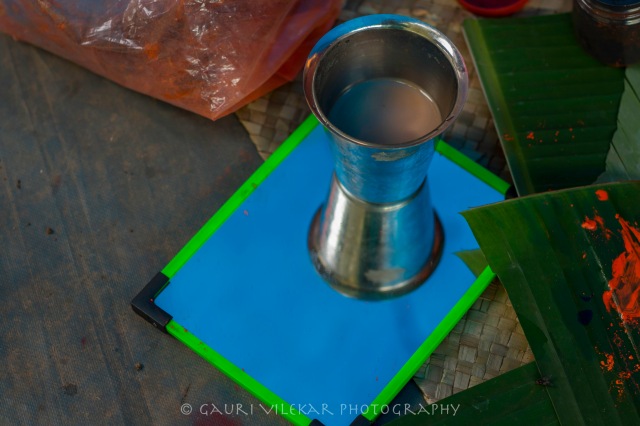
‘Chechi, chaaay veno?’ (Sister, would you like some tea?), asked the make-up man enthusiastically, as he offered me half a tumbler of tea. I sat inside the ten-feet wide make-up room; basically just a thatched shed, and watched him paint the face of a performer who had slid off into a slumber and snored gently. Another man sitting outside, plaited lovely garlands and jewellery from delicate palm fronds. All of this seemed familiar, since it was only a month ago that I had visited Thalassery for my first Theyyam where I had seen the fiesta of 39 Kuttichatans. And here I was, back in Kerala for more, but this time, in a rustic village called Kanhileri, to experience the most resplendent of all Theyyams, namely, the ‘Muchilott Bhagavathi’.

It had taken me two weeks of unsuccessful attempts to get through to someone locally who could help, until, finally, I chanced upon my host, Mr. Krishnakumar, who was kind enough to make room for a perfect stranger in his home. I got dropped off by an auto in the wee hours of a humid April morning. I woke up to a generous platter of puttu*, appams*, kadala-curry* and bananas, served by his affectionate mother for breakfast. A bath in the cool water pulled up from the well attached to the bathroom was instantly refreshing. I was immensely moved by the family’s hospitality; I later understood that I was the first tourist to have ever visited Kanhileri!
Kanhileri was quiet and peaceful, with a handful of houses amid tall arcadia and rubber trees and a mountain in the backdrop. The Kaav* was a stone-throw away from Krishnakumar’s home. I could hear the beat of the Chenddas* and the clangs of the Illathalams* from a distance. The Kaav was a small block, yet impressive with a tapering terracotta roof (typical of a temple in rural Kerala). A row of ethnic brass lamps hung from its rim that was decorated with strings of vibrant yellow and orange marigold flowers. Food was being cooked adjacent to the temple in huge aluminium vessels, to be served as Prasadam* at lunch. In contrast to most temples in India that strictly serve only pure vegetarian food to its devotees, this one had a non-vegetarian dish in the making. I sat under the huge blue tarpaulin canopy, sweating profusely as I juggled between gobbling on piping hot Sambar* and rice and chit-chatting with curious women eager to know everything about me. Within no time, I felt like being part of one large family. There is no place else where one could connect more easily than our own countryside, despite the worst of communication barriers!
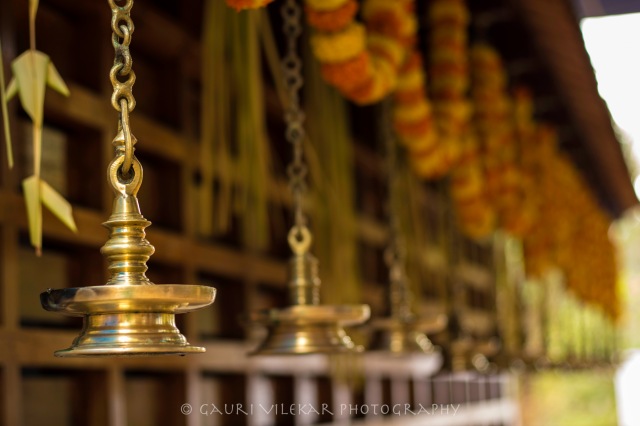
A quick introduction to Theyyam – Theyyam is a traditional form of worship, unique to the coastal (Malabar) region of Kerala. It’s origin can be traced back to the 13th century or perhaps, even earlier. Manakadan Veliya Gurukkal, the Aashrit (dependent) of the King, Kolathiri Raja, is believed to be the first tutor of Theyyam. Theyyam is a family run tradition and is passed on from one generation to the other. The performers are males who take up the roles of female deities too. The dances start with slow movements and gradually pace up with the rhythm. As the act progresses, the performers reach a state of trance. The dancers are considered to be immortal and divine incarnations of the deity they enact. At the end of each Theyyam, devotees seek their blessings and advices on their fortunes. Read more details here When ‘Gods’ Descend…
In my narration below, I have addressed the performers as “she” wherever the character played is female, to bring out the true essence of the Theyyam.
Puliyoor Kannan (Male)
By evening, Theyyam commenced with the Puliyoor Kannan, who came dressed in a wild cat-like attire. His face was painted red while his eye-sockets had a thick outline of jet black. His chest and stomach were bare and painted yellow and he wore a large crown. As he danced with interrogative expressions, children gathered around him, nudging, teasing and screaming their heart out in his ears. Each time this happened, he tried to animatedly scare them away. However, as the cadence gained speed, the Puliyoor Kannan moved into trance, and was now encouraging the kids to scream louder and louder. To a normal person, this would have been enough to tear the eardrums apart! But the Kannan seemed to be unaffected by the hullabaloo and continued dancing till the beats continued..
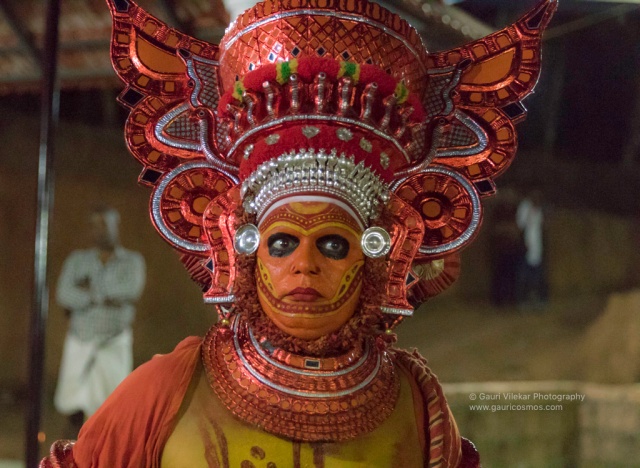
Puliyoor Kannan
This was followed by Karanavar (Male), who resembled a king with a dense fake beard extended from one ear to ear. He was soon accompanied by another Karnavar. A series of Vellattams* continued through the night, however, since most of the names sounded similar to what I had seen in Thalassery, I decided to skip them.
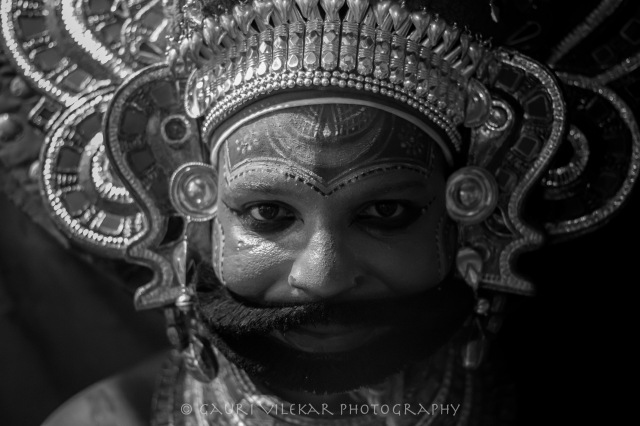
Karanavar with a false beard extending from ear to ear
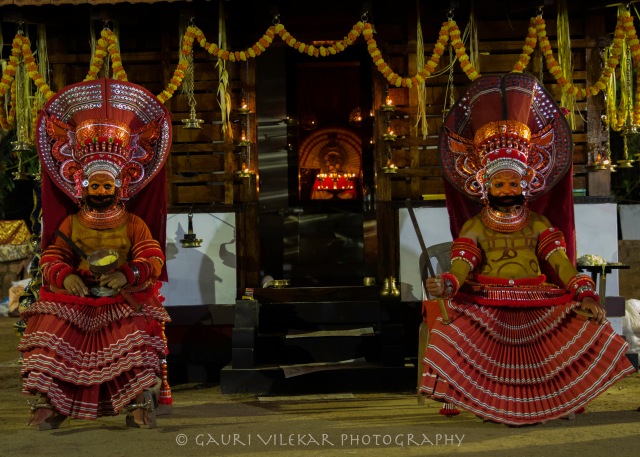
Narayil Bhagavathi (Female)
An overcast morning with intermittent showers provided momentary relief from the unbearable humidity. A bonfire with logs was lit up in front of the Kaav. The Narayil Bhagavati paraded in poise, holding an iron machete and a brass shield. She wore a metal upper-body resembling a bare-chested woman with a huge yellow snake painted around each bosom. The skirt made of stripped palm fronds had Mashaals* affixed to the front which were lit up as the Bhagavathi swirled and danced in a frenzy around the bonfire. After a while, she was taken to the rear of the Kaav where she slit the neck of a live hen (the act of Bali) and drank its blood. I watched from a distance as I just couldn’t gather enough guts to see the act up-close. This bird was later used in the meal as ‘prasadam’ for the day.
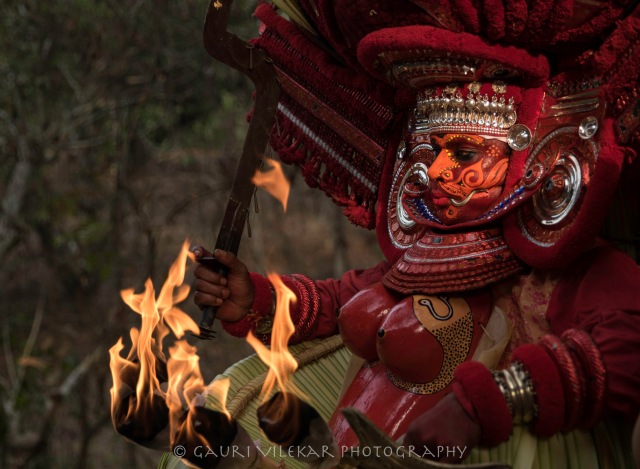
Narayil Bhagavathi
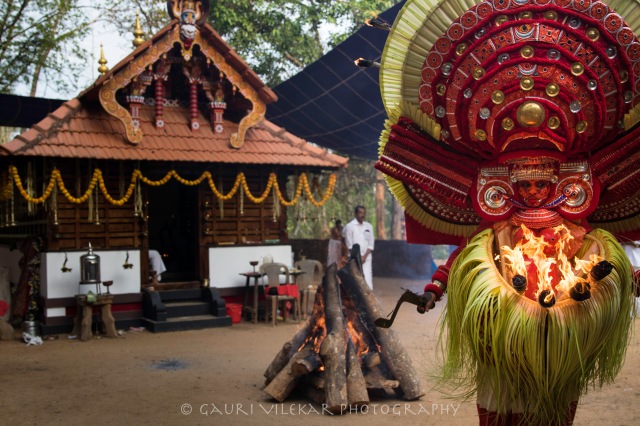
Kannangott Bhagavathi (Female)
As the bonfire reduced to charcoal, a pair of Kannangott Bhagavathis arrived. I noticed that size and innateness of the head gear kept increasing with each Theyyam. The performers stooped low and spun with acceleration so as to blow ash from the bonfire Basically, the headgear acted as a fan, sending out clouds of ash in the air, rendering the Theyyam quite dramatic to watch!
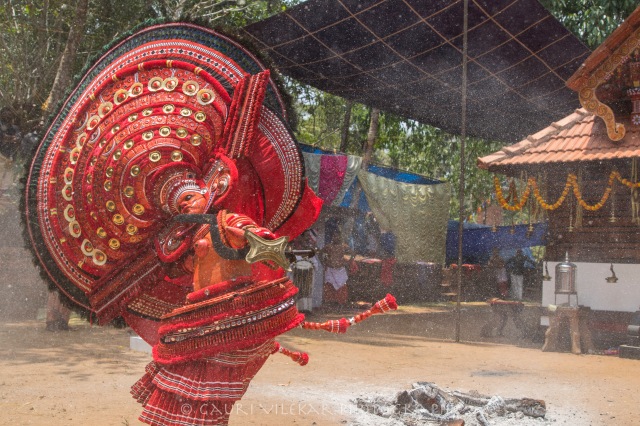
The Kannangott Bhagavati spins with speed and blows a cloud of fine charcoal dust in the air
Vishnumoorthy (Male)
Vishnumoorthy was a stunt man whose skirt was secured to his chest rather than his waist, making his arms rest almost parallel to his chest at right angles. (Read through the tale behind this Theyyam in my previous blog). When ‘Gods’ Descend…
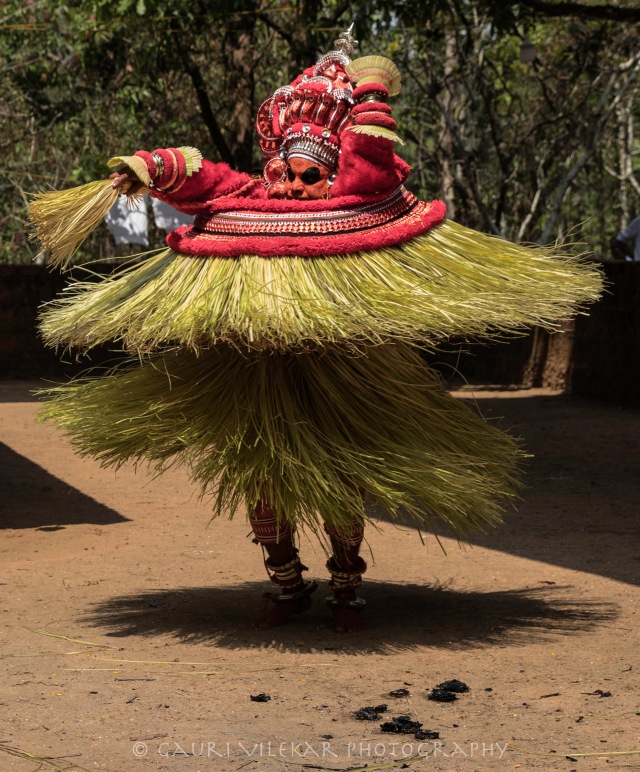
Vishnumoorthy has his skirt tied to his chest.
Muchilott Bhagavathi (Female)
By late noon, devotees were getting anxious to witness the last but the most spectacular Theyyam. I was asked to hurry to the backside of the Kaav where the goddess, hidden behind a white curtain held by a few priests, swayed gently to the slow-paced thump of the Chendda and the metallic timbre of the Illathalam. When the curtain finally dropped, I saw the first glimpse of the divine Muchilott Bhagavathi, soaked in crimson from head to toe. Opaque metallic eyes and a set of demon-like teeth shimmered through a fragile veil of delicate Ixora flowers that were strung carefully from her massive crown. Her box-shaped rectangular skirt and jewellery were equally humungous and elaborate. An exceptional personification of God infused with visual grandeur and powerful auras blew me off my feet! My eyes couldn’t look away from her charisma as I stood in front of her, weightless and speechless..
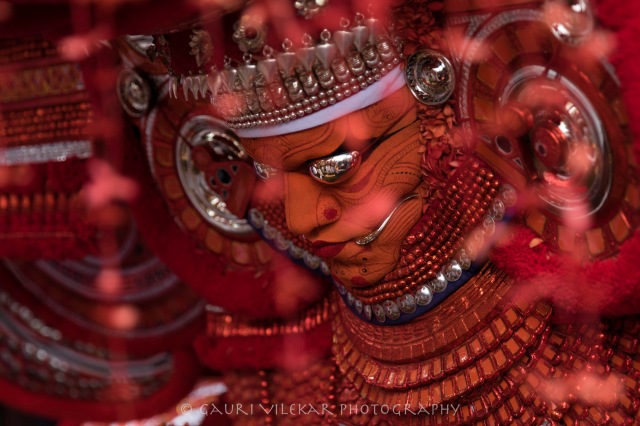
The stunning glimpse of the Muchilott Bhagavati with shimmering eyes and teeth behind the veil of Ixora flowers.
The Bhagavati took Pradakhsinaas* of the Kaav and sought blessings of the deity. With two fire torches in hand, she danced eternally under the blue tarpaulin to the drumming of the Chenddas and the pitter-patter of the heavy rain. She was then escorted to the temple well where she saw her reflection in the water for a quick second. The eye shield that was scalding due to the heat from the fire torch, was carefully detached. I could see steam coming off when cold water was dabbed on her eyes with a piece of cloth. The Bhagavati had danced relentlessly for hours, carrying along her costume that weighed no less than thirty kgs. The Theyyam concluded with devotees thronging to seek blessings of the incarnate ‘Muchilott Bhagavathi’.
The wait had paid off. And I had one more brilliant story to take back home from ‘God’s own country!’
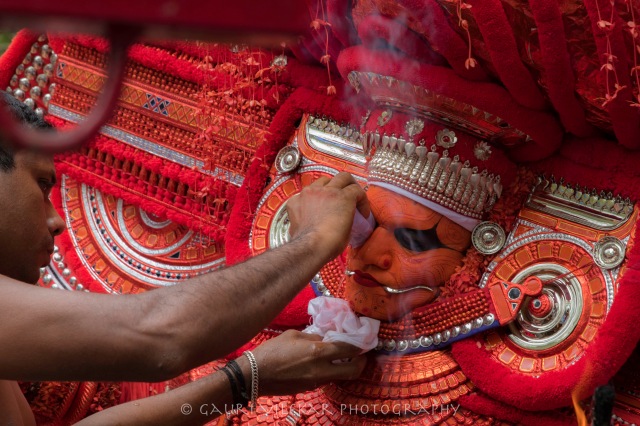
The eyes are patted with water after the eye shield is removed. The steam is clearly visible

The stunning grandeur of the goddess is nothing less than a phenomenon!
Tell tales around Muchilott Bhagavathi
Of the many interesting stories behind the inception of Muchilott Bhagavati, one of it claims that the goddess emerged from the sweat of Lord Shiva while he performed the Taandav* The rather interesting one revolves around the young and knowledgeable Brahmin girl, named Bhagavathi in a village called Muchilott, who had an unbeatable understanding of the Vedas*. The Gurus of the village tried hard to win over arguments with her, but failed. When they realised that they stood no chance of outsmarting her, they laid a trap by asking her two questions. ‘What was the most excruciating pain and what was the greatest pleasure in the world’. The innocent Bhagavati, out of here acute Vedic mastery, replied that it was labour pain and erotic pleasure. Alleging that an unmarried girl could not have this wisdom without experiencing it, the Gurus successfully expelled her from Muchilott on the grounds that she was not a virgin. Struck with grief, Bhagavathi immolated herself in fire. She insisted a young boy carrying a pot of oil to pour it on her despite his strong resistance. When the boy reached home, his pot was automatically refilled with oil and when he went to the well, he saw the refection of the same girl in its water. Soon after, Lord Shiva sent her back to earth with godly powers and that’s how she was resurrected as Sri Muchilott Bhagavati, the goddess of knowledge and prosperity. When the villagers came to know of her reincarnation, they built a temple near the same well in Muchilott. (I presume that the act of the Bhagavathi seeing her reflection in the well during the Theyyam originated from this)
Synonyms:
*Prasadam– a devotional offering made to a god, typically consisting of food that is later shared among devotees.
*Puttu (steamed rice cake) appams( steamed rice pancake, an equivalent of dosa) and kadala-curry (gravy made of black chickpeas usually served with puttu and appams). This is the most common breakfast in Kerala.
*Chenddas and Ilathalams – Traditional musical instruments of Kerala
*Kaav – temple
*Prasadam – religious offering, normally consumed by worshippers after worship
*Sambar- A tangy, thick soup like gravy made with Daal and vegetables, prepared in South India.
*Vellattam- Day 2 of worship with longer duration of dance performance. While day 1 comprises of vocal admiration and minimal dance-Natathira Orthottam. Main performances happen on day 3, namely Theyyam
*Mashaals – fire torches
*Pradakhsinaas- circumambulation
*Taandav-the dance of death, associated with Lord Shiva
*Vedas- Ancient manuscripts of Hinduism
Snippets
Theyyam, one of the most ancient and traditional form of worship, is unique to the Malabar region of Kerala. As it seeps into coastal Karnataka, it manifests itself as ‘Bhootakola’. Theyyam, I am told, is considered to be a form of Upasna or the attainment of God itself! There are close to 300 forms of Theyyams, that happen across North Kerala between December and April. Every Theyyam is unique in its own way since each has a story behind it. Having said that, Muchilott Bhagavati is the grandest in my opinion.
I have complied the below list of temples where you could see the Muchilott Bhagavathi. The dates given here might shift a bit, year on year. All of these are typical villages and some might not have ever seen a tourist before, like in my case. You are suggested to google up info and make your own plan. I prefer it that way than to team up with a tour agency who gives everything to you on a platter.
For Kanhileri, you may reach out to Mr. Krishnakumar. Write in to me for further info and I will be glad to assist you!
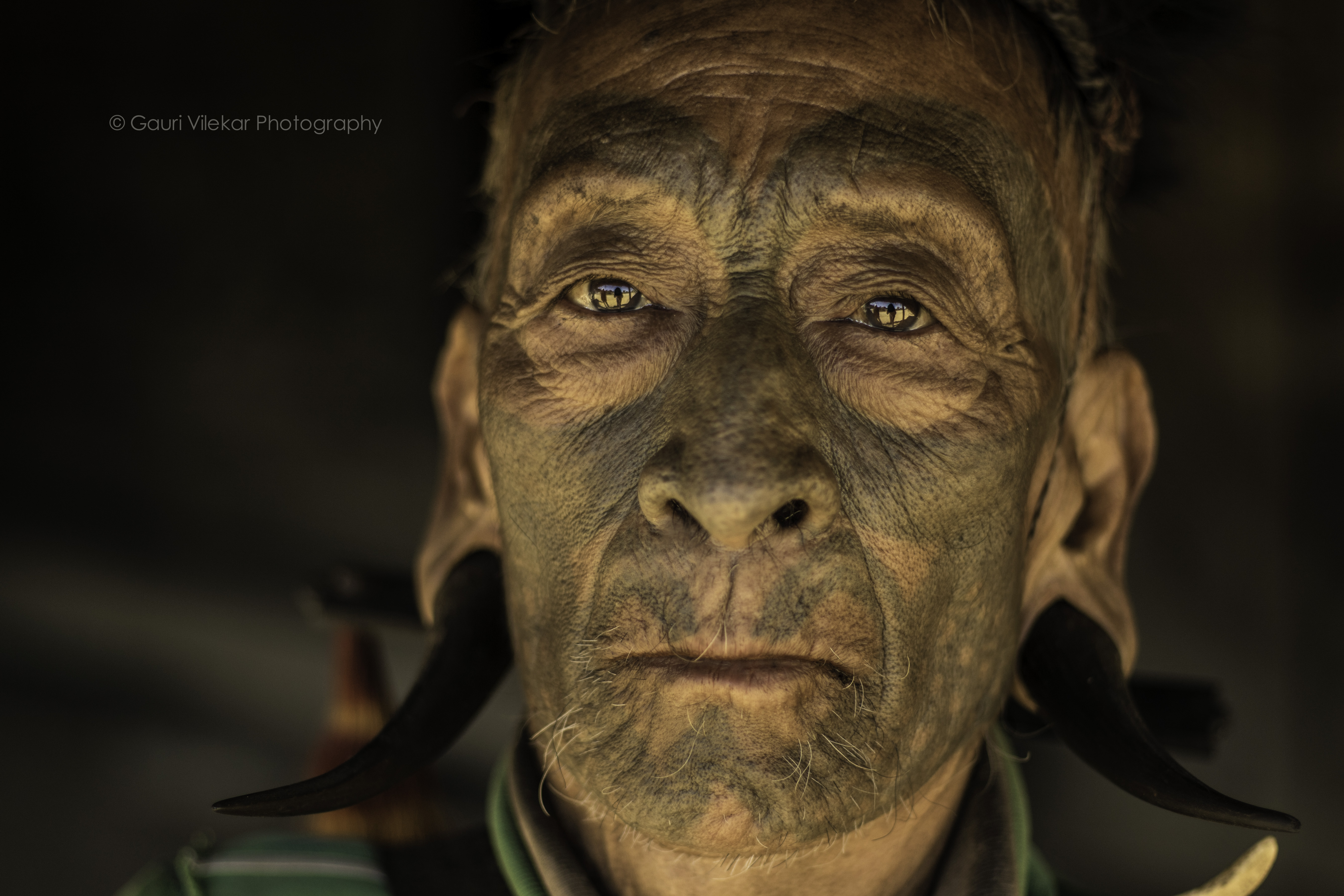
Epic like Apocalypto but Indian style. Wonderfully Written.
LikeLike
thank you for your kind words Zameer !!
LikeLike
Your wonderful writing style makes it so much closer to heart. Keep up the good work of spreading the knowledge. The pictures have come out gorgeous.
LikeLike
Yet another dose of motivation from you! Don’t know how to thank you much doc !!
LikeLike